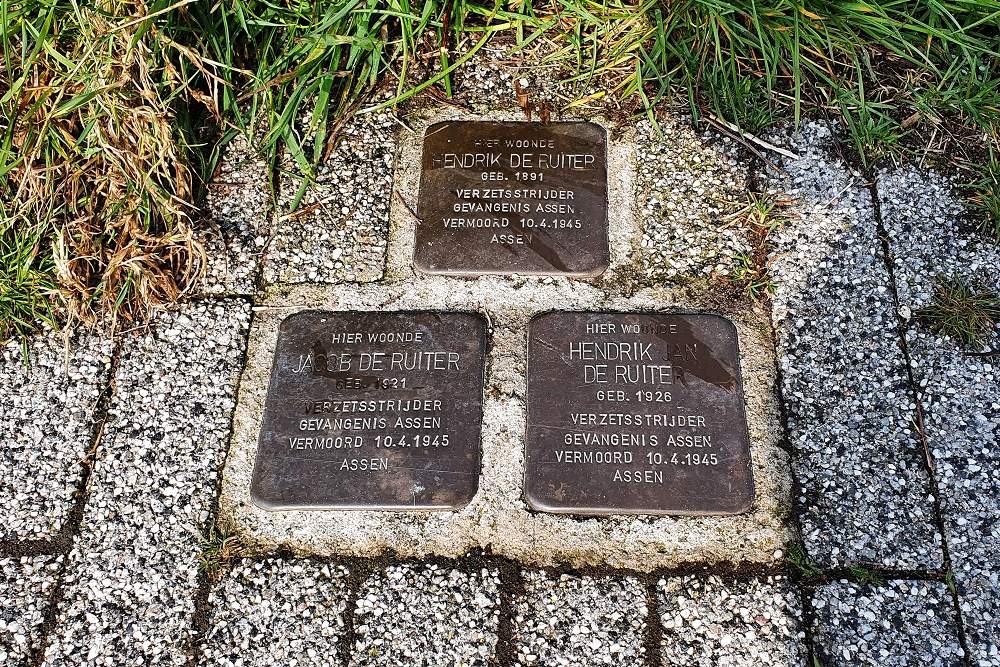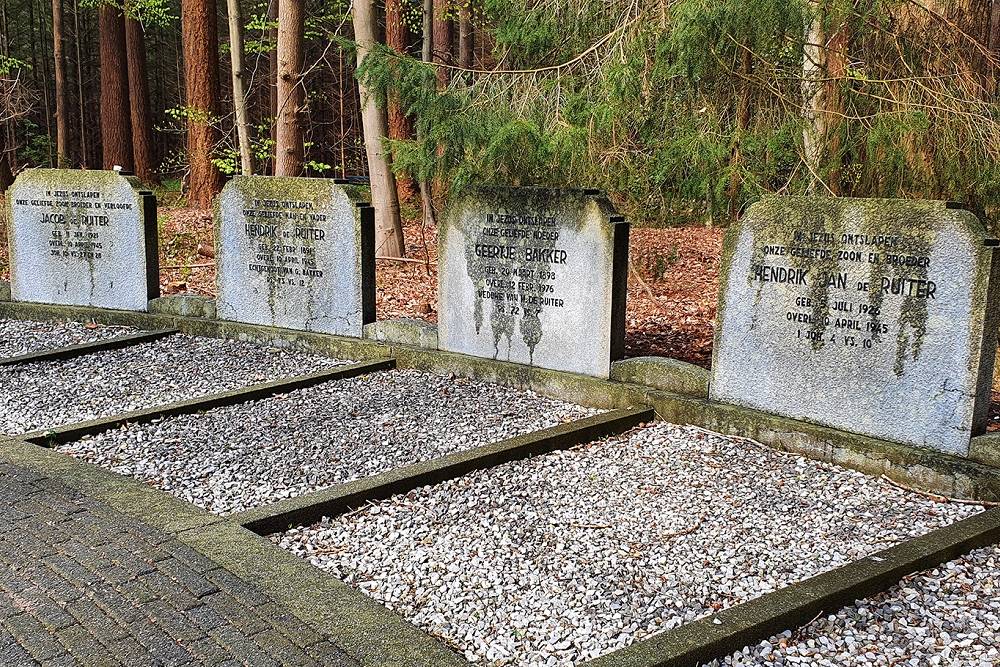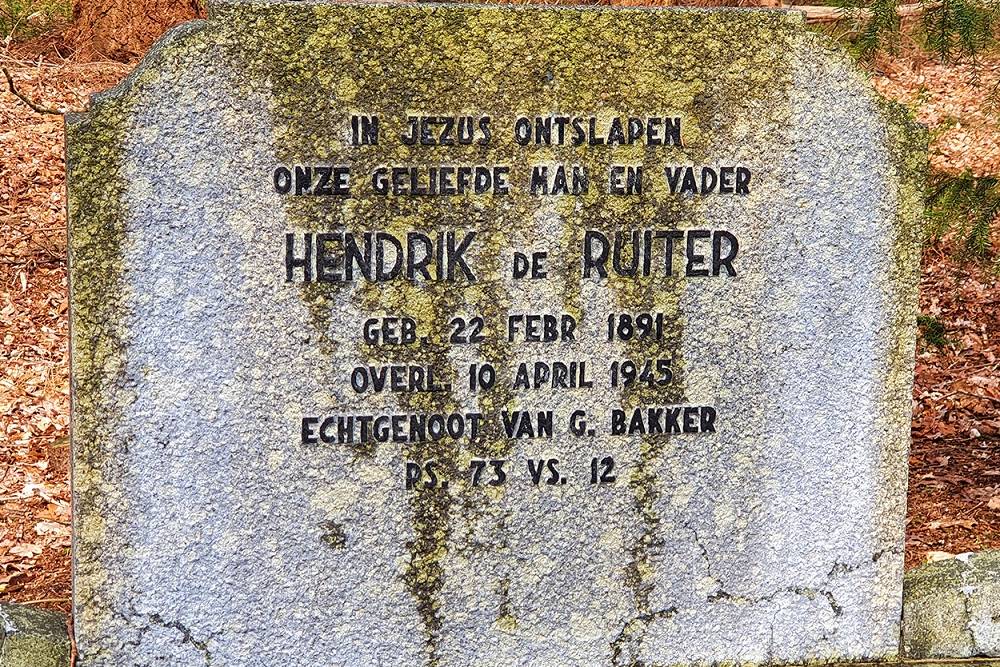Stumbling Stones Hendrik de Ruiterstraat
STOLPERSTEINE / STUMBLING STONES
for:
Hendrik de Ruiter
Jacob de Ruiter
Hendrik Jan De Ruiter.
Legion of Honor Award and Stumbling Stones for Family de Ruiter
On Tuesday, April 10, 1945, around a quarter to eight in the evening, a gunfire sounded from the Stadsbroek in Assen. German SD men shot 14 prisoners just past the heating pond of the old swimming pool on Broeklaan. Among the victims three men from one Asser family. Hendrik de Ruiter (52) and his sons Jacob 'Jaap' de Ruiter (23) and Hendrik Jan 'Henk' de Ruiter (18).
The residents of Assen had been arrested three weeks earlier for resistance work and for hiding a secret agent who had been hidden in the home of livestock dealer Hendrik de Ruiter on Parallelstraat for five months with a 'signal key', with which he sent messages to England.
The news of the execution spread like wildfire through Assen the next morning and also reached the Tromp family from Prins Hendrikstraat. 17-year-old Berend Tromp hears the news at home and is upset for days. 'Bé' Tromp, now at the respectable age of 87, knows all too well: "We were all completely lost. The whole neighborhood. I thought it was terrible. "Seventy years later, the event still affects Berend Tromp." I knew the family well and we all played in the neighborhood with great regularity. Shooting with the slingshot was our favorite activity. a lot of mischief. The boys from De Ruiter often did not participate. Father Hendrik was a strict man. In our group we always called him 'de Bok'. Everyone in our group trembled for that man ", said Tromp.
Hendrik de Ruiter's strict appearance must have had to do with the practices in which Hendrik de Ruiter and his family were involved. De Ruiter offered shelter to secret agent Cornelis Hendrik van Bemmel who sent all collected information from the resistance with his transmitter to the Intelligence Bureau (BI), which had been based in London since March 1943 and which worked closely with the British Secret Intelligence Service (SIS). Son Jaap de Ruiter acted as a courier for van Bemmel for months. He made sure that incoming messages reached the resistance groups.
The family managed to hide the secret agent in the house at 11 Parralelstraat 11 for months until the Germans managed to find out "seinsleutel IJsberg" (translation: iceberg key) and the Sicherheitsdienst (SD) stormed into the house of the de Ruiter family on Wednesday 21 March 1945. "It was an exciting event. The whole neighborhood was cordoned off and the Germans all had dogs with them ", Bé Tromp remembers the day of the raid.
Secret agent Van Bemmel is found by the SD behind a scrap wall on the top floor in the house of the de Ruiter family. The Germans want to arrest the man, but he jumps behind the wall and tries to escape from his attackers with his pistol. In doing so, he fatally wounded two Germans, but was also seriously injured. The man collapses after the brief firefight and the Germans have Van Bemmel transported to the Wilhelmina Hospital on Oosterhoutstraat, where he died later that day. The De Ruiter family is taken to the House of Detention.
The raid caused a lot of commotion in the neighborhood. "We were used to a few things at the time, but this came like a thunderbolt," Tromp says. "You saw Germans around you all day and we also played a lot with them. So we shouted "Tommies ... Tommies", pretending we had seen an English soldier. I even got stuck for it once. They locked me up in the Marktcafé on the Veemarkt site. Fortunately my father got me "released" again. My father was a butcher and we always had meat at home, so he bought me free again ".
In the House of Detention, Hendrik de Ruiter and his sons were harshly interrogated by the SD. His 10-year-old daughter Aaf "Aafje" de Ruiter was allowed to leave the detention center in Assen on March 30, 1945, one day before her eleventh birthday. Aaf was picked up by an aunt who lived in the former parental home of father De Ruiter at Parralelstraat 4. In the early evening of April 10, Hendrik de Ruiter and his two sons were picked up and taken away in a truck. On the edge of the Asserbos, Hendrik de Ruiter and his sons Jacob 'Jaap' de Ruiter and Hendrik Jan 'Henk' de Ruiter, as well as the Asser resistance fighters Anne Smallenbroek and Cornelis Broerse, are shot by a group of SD men.
In the night of 12 to 13 April 1945, Canadian soldiers drive into Assen and manage to liberate the city from the German occupiers. On April 18, the bodies of father De Ruiter and his sons are buried under great public interest in the Zuider cemetery on the Beilerstraat in Assen.
The "remaining" family members mother Geertje de Ruiter-Bakker, her two sons Jan de Ruiter, Piet de Ruiter, who were not in Assen at the time of the raid, and Aaf de Ruiter moved back into the house on Parralelstraat after the war.
The German artist Gunter Demnig started placing the first Stolpersteine in 1997 in the Berlin's Kreuzberg district.
Meanwhile there are Stolpersteine in many countries.
It reminds the Holocaust in World War II.
A Stolperstein is a concrete stone of 10 x 10cm, with a brass plate on top, in which the name, date of birth and decease and also place of decease is punched into.
The Stolperstein gets a place in the pavement in front of the former house of the victim.
By doing this, Gunter Demnig gives a private memorial to each victim.
His motto is: 'A HUMAN BEING IS FORGOTTEN ONLY WHEN HIS OR HER NAME IS FORGOTTEN'.
Do you have more information about this location? Inform us!
Source
- Text: H. de Jong - Assen en TracesOfWar.com
- Photos: H. de Jong – Assen
Nearby
Museum
- Stoottroepenmuseum - Johan Willem Frisokazerne - Assen
- Camp Westerbork Remembrance Centre - Hooghalen
Point of interest
- House of the Resistance Noord Drenthe - Assen
- Regional Quarter Nationale Jeugdstorm - Assen
- Former House of Detention Assen - Assen
Monument
- Commemorative column "Route of the Persecution" - Assen
- Memorial Deported Jews Oranjestraat - Assen
- Memorial Deportation Assen - Assen
Cemetery
- Commonwealth War Graves Zuiderbegraafplaats - Assen
- Dutch War Graves Zuiderbegraafplaats Assen - Assen
- Jewish War Graves Twijfelveld - Assen
Remembrance Stone
- Stumbling Stones Prins Hendrikstraat 1a - Assen
- Stumbling Stones Oranjestraat 47 - Assen
- Stumbling Stone Oranjestraat 45 - Assen
Fortification
- German Antitank Ditch Assen - Assen
- German Antitank Ditch Assen - Assen
- German Anti-tank Ditch Balloërveld - Balloerveld







